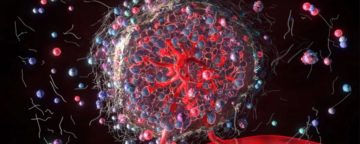Alison Halliday in The Scientist:
 Cancer cells don’t exist in isolation – instead, they live within a complex ecosystem that also includes immune cells, stromal cells, the extracellular matrix, blood vessels and many other factors. The components of the tumor microenvironment constantly interact and influence each other, which can affect tumor behavior in either positive or negative ways.
Cancer cells don’t exist in isolation – instead, they live within a complex ecosystem that also includes immune cells, stromal cells, the extracellular matrix, blood vessels and many other factors. The components of the tumor microenvironment constantly interact and influence each other, which can affect tumor behavior in either positive or negative ways.
“Tumor cells can take advantage of their surrounding microenvironment – by co-opting nutrients and blocking immune surveillance and the host response. But importantly, the tumor microenvironment can also curtail tumor growth and prevent metastasis,” says Janis Taube, professor of dermatology and pathology and co-director of the Mark Foundation for Advanced Genomics and Imaging at Johns Hopkins University, Baltimore. “It’s a double-edged sword – and so it’s all about getting the balance right and trying to tip it more in favor of the host than the tumor.”
Given the diversity of cell types and molecules that form the tumor microenvironment, it is necessary to apply a systems biology approach to study it.
More here.
